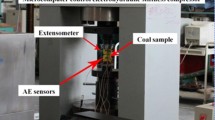In the process of oil and gas drilling, under the action of mechanics, the wall rock will produce complex and high incidence of stress concentration, deformation, damage, cracking, fracture and other damage behaviors, resulting in the wall instability phenomenon. It may lead to complex accidents underground, resulting in huge economic losses. Therefore, it is of great theoretical and practical significance to grasp the failure behavior law of wellbore rock under mechanical action and study its failure mechanism. The early research on the instability and failure behavior of wellbore rocks was mainly based on the theory of fracture mechanics. Later, the theory of damage mechanics was introduced, which were all based on the theory of continuum. The development and change process of rock mechanical failure from small to large and from quantitative change to qualitative change caused by the accumulation of multiple defects in the internal microstructure of the rock can be described. This paper adopts the theory of configuration mechanics, which can well describe the complex microstructure and multi-defect evolution of materials such as inclusions, holes, dislocations, cracks, plastic flow, discontinuity, heterogeneity and anisotropy, and can be used to describe fracture mechanics. It provides a new idea for solving the complex defect problem.

Similar content being viewed by others
References
Guo Y., Li Q. Material configurational forces applied to mixed mode crack propagation [J]. Theoretical and Applied Fracture Mechanics, 2017, 89 (1):147-157.
Gu B., Guo Y., Li Q. Crack interacting with an individual inclusion by the fracture criterion of configurational force [J]. Lixue Xuebao/chinese Journal of Theoretical & Applied Mechanics, 2017, 49(6):1312-1321.
Wu Zhihong, Wang Fangwen, Liu Ran, et al. Research on Composite Fatigue Crack Growth Behavior Driven by Material Configuration Force [J]. Journal of Xi’an Jiaotong University, 2018, 52(09):50-58.
Eshelby J. D. The Continuum Theory of Lattice Defects.Solid State Physics, 1956, 3:79-144
Knowles J. K., Sternberg E. On a class of conservation laws in linearized and finite elastidty [J]. Archive for Rational Mechanics and Analysis, 1972, 44(3):187-211.
Chen Y. M-integral analysis for two-dimensional solids with strongly interacting microcracks. Part II: in the brittle phase of an infinite metal/ceramic biomaterial [J]. International Journal of Solids and Structures, 2001, 38(2):3213-3232.
Chang J. H., Chien A. J. Evaluation of M-integral for anisotropic elastic media with multiple defects [J]. International Journal of Fracture, 2002, 114(3):267-289.
Chang J. H., Wu W. H. Using M-integral for multi-cracked problems subjected to nonconservative and nonuniform crack surface tractions [J]. International Journal of Solids & Structures, 2011, 48(19):2605-2613.
Yifeng H., Yiheng C. The M-Integral Description for a Brittle Plane Strip with Two Cracks Before and After Coalescence [J]. Acta Mechanica, 2009, 204(1-2):109-123.
Wang F. W., Chen Y. H. Fatigue damage driving force based on the M-integral concept [J]. Procedia Engineering, 2010, 2(1):231-239.
Yu Ningyu, Li Qun. Explicit Relationship between M Integral and Inclusion/Defect Elastic Modulus [J]. Chinese Journal of Mechanics, 2014, 046(001):87-93.
Yu N. Y., Li Q. Failure theory via the concept of material configurational forces associated with the M-integral [J]. International Journal of Solids and Structures, 2013, 50(25-26):4320-4332.
Zhu Wenjie, Lv Junnan, Li Qun. Characterization of Equivalent Damage Area/Volume of Micro-Defects in Brittle Materials Based on M Integral [J]. Chinese Journal of Mechanics, 2018(2):297-306.
Acknowledgments
This work was supported by “National Natural Science Foundation of China, Comprehensive analysis and computation simulation of wellbore instability based on disturbed state concept”, the project number is 51974255; “Natural Science Basic Research Program of Shaanxi, Research on Instability Mechanism of Shale wall based on Damage Rheological Effect”, the project number is 2020JM-544.
Author information
Authors and Affiliations
Corresponding author
Additional information
Translated from Khimiya i Tekhnologiya Topliv i Masel, No. 6, pp. 82–85 November – December 2022
Rights and permissions
Springer Nature or its licensor (e.g. a society or other partner) holds exclusive rights to this article under a publishing agreement with the author(s) or other rightsholder(s); author self-archiving of the accepted manuscript version of this article is solely governed by the terms of such publishing agreement and applicable law.
About this article
Cite this article
Liu, W., Qu, Z. & Wang, P. Study of Rock Damage Behavior Based on Configurational Mechanics. Chem Technol Fuels Oils 58, 1011–1017 (2023). https://doi.org/10.1007/s10553-023-01483-y
Published:
Issue Date:
DOI: https://doi.org/10.1007/s10553-023-01483-y




